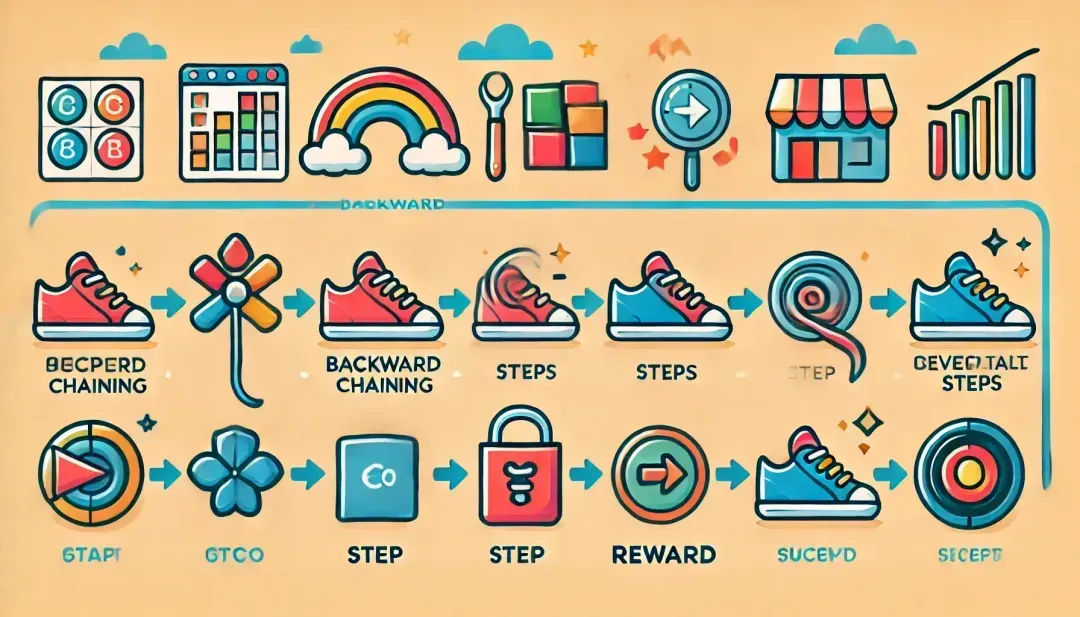Backward chaining is a technique used in Applied Behavior Analysis (ABA) to teach complex tasks by breaking them down into smaller steps, starting with the last step first. This approach is particularly useful for helping individuals with developmental disabilities, such as those on the autism spectrum, learn new skills.
The idea behind backward chaining is to make learning less overwhelming and more rewarding. By starting with the final step, the learner experiences success right away, which can boost motivation. For instance, if the goal is to teach someone how to tie their shoes, backward chaining might start by having them pull the laces tight after the bow is made. As they master that step, earlier steps are gradually introduced until they can tie their shoes from start to finish.
Advantages of Backward Chaining for Skill Development
Backward chaining has several key advantages that make it an effective teaching method, especially in ABA therapy:
- Boosts Motivation: Because the learner starts with the last step and experiences success quickly, they’re more likely to stay engaged and motivated to continue learning.
- Reduces Frustration: This method helps avoid the frustration that can come from struggling with difficult initial steps and not participating in the outcome of the skill. By starting with a step that leads to a finished product or event, learners build confidence gradually.
- Provides Clear Reinforcement: Immediate reinforcement, given after the completion of the final step, strengthens the connection between the action and the reward, making the learning process more effective.
- Progresses at a Customizable Pace: Backward chaining allows the learning process to be adjusted to suit the individual’s needs. Each step can be introduced slowly, ensuring that the learner is comfortable before moving on.
- Promotes Independence: The ultimate goal of backward chaining is to help the learner become independent. As they progress through each step, they build the skills needed to ultimately perform the task on their own.
How to Apply Backward Chaining in ABA
Implementing backward chaining in ABA involves a step-by-step approach. Here’s how you can do it:
- Define the Task: Start by identifying the task you want to teach. Break it down into smaller, manageable steps. For example, teaching handwashing might involve steps like turning on the faucet, wetting hands, applying soap, scrubbing, rinsing, and drying.
- Analyze the Steps: Conduct a task analysis to detail each step. This breakdown helps in ensuring that each part of the task is clear and teachable.
- Start with the Last Step: Begin by teaching the learner the final step of the task. For instance, you might start by teaching them to dry their hands after washing. Use prompts and guidance as necessary to help them perform the step correctly.
- Reinforce Immediately: Provide positive reinforcement right after the learner successfully completes the final step. This could be praise, a small reward, or anything else that motivates them.
- Move Backward Through Steps: Once the learner masters the final step, introduce the step that comes just before it. Continue to guide and reinforce them as they progress through each step.
- Gradually Reduce Assistance: As the learner becomes more proficient, reduce the prompts to encourage independence. The aim is to help them complete the task with minimal assistance.
- Practice the Full Task: After mastering all the steps individually, have the learner practice the entire sequence from start to finish. Continue to provide reinforcement for successful completion until natural reinforcement takes over.
Backward Chaining vs. Forward Chaining: A Comparison
While backward chaining is effective, it’s not the only method used in ABA. Forward chaining is another approach, and the choice between the two depends on the specific needs of the learner, their skill level, and the task at hand.
The table below compares both of these approaches to show how they differ.

Real-Life Applications of Backward Chaining
Backward chaining can be applied in many real-life situations, helping individuals with developmental disabilities learn essential skills. Here are some examples:
Daily Living Skills
Backward chaining is often used to teach everyday tasks like dressing, grooming, and personal hygiene. For instance, when teaching a child to put on a jacket, you might start by teaching them to zip it up after it’s on. As they master that, you would then teach them to put their arms through the sleeves, and so on.
Good Academic Performance
In educational settings, backward chaining can help with tasks like completing a math problem, writing an essay, or following multi-step instructions. A teacher might start by having a student write the conclusion of an essay, then work backward to the introduction.
Professional Training
For older children and adults, backward chaining can be used to teach job-related skills like assembling products or performing clerical tasks. Starting with the final step ensures the individual access the final product, helping them work towards completing the task independently, which is crucial in a work environment.
Social Skills
Backward chaining can also be applied to teach social skills, such as initiating conversations, participating in group activities, or playing games with peers. Starting with a successful social exchange keeps learners engaged and motivated.
Conclusion
Backward chaining is an effective technique in ABA, that offers a structured and efficient way to teach complicated tasks to autistic people. By starting with the final step and working backward, this method makes learning less intimidating and more rewarding. Whether it’s used to teach daily living skills, academic tasks, professional training or to enhance social skills, backward chaining can be customized to fit the unique needs of each individual, increasing the probability of success.


